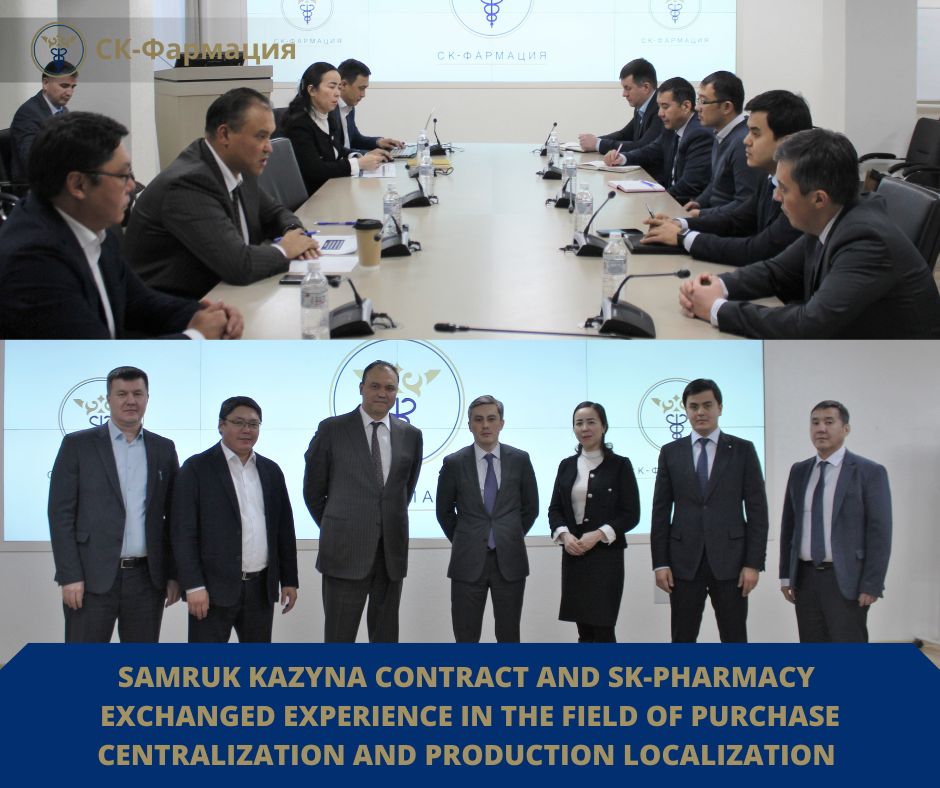
On January 23, at the site of the Single Distributor "SK-Pharmacy" a meeting was held to exchange experience in the field of centralization of procurement and localization of production with "Samruk-Kazyna Contract" LLP, which was represented by Deputy General Director - Darkhan Ramazanov, Director of the Department of Category Procurement Management - Aidar Kuskaliyev, expert of the department of categorical procurement management - Aizhan Bainiyazova.
Samruk-Kazyna Contract LLP shared its experience in applying the mechanism and principles of the category purchase strategy, as well as the difference between the category purchase system and the current system for the purchase of medicines and medical devices.
Purchasing category strategies are a kind of mini-rules that determine the optimal approach to the purchase of a particular category of goods. During the presentations, representatives of Samruk-Kazyna JSC said that the procurement category strategy has a number of goals and objectives.
First of all, this contributes to cost optimization, and is also the engine of such processes as modernizing the production capacities of commodity producers, reducing the rejection rate, concluding long-term contracts, optimizing the operating costs of customers, and so on.
What is the difference between a standard tender and a category strategy?
Bidding is based on selection by the supplier under certain conditions, and categorical strategies involve purchasing based on the total cost of ownership. That is, not only the purchase price is taken into account, but also future costs that can significantly affect the total cost of the equipment or service.
The Head of State previously instructed to increase the share of medicines and medical products of domestic production from the existing 17% to 50% as early as 2025. Category management, in turn, is a powerful tool to support domestic producers.
The speakers, using the example of the procurement strategy for the category “Special clothing”, explained that the purchase is made from Kazakhstani manufacturers, which have certain requirements for the use of domestic raw materials and accessories. With this procurement approach, it is also possible to improve the quality of the purchased goods, reduce labor costs for procurement activities, unify the approach to qualifying potential suppliers and save money through consolidation and standardization.
Taking into account the effective experience of applying various cases of the category purchase strategy, this mechanism is relevant in the framework of the centralization of the purchase of medical equipment on the basis of SK-Pharmacy.
Analytical procedures are carried out when creating this or that purchasing category strategy. This includes an analysis of the historical costs of the customer, approved procurement procedures, their shortcomings, the quality of the supply of goods or the performance of some work by suppliers.
Also, when developing, it is important to understand how the customer plans his need for purchases. The process of regulating contractual relations with suppliers, the formation of stocks is studied in detail. To develop a category strategy, it is necessary to study three important criteria, these are the amount of costs, the criticality of the category for business, and the synergy effect from the consolidation of purchases.
Each strategy prescribes the procurement procedure for a whole category of goods, works and services, including those covering procurement, storage, transportation, maintenance, repair and disposal, which will positively affect the procurement and supply of medicines and medical equipment.
After all the speeches, the parties actively discussed the introduction of this mechanism into the single distribution system, analysis of existing and potential problems, and also exchanged views on joint projects.
As a result of the meeting, an agreement was reached on providing methodological assistance in the framework of off-take contracts and a category procurement strategy.
Reference:
Samruk-Kazyna Contract LLP, a subsidiary of National Welfare Fund Samruk-Kazyna JSC.
The main mission of the CCM is to improve and develop the procurement system of the organizations that are part of the Holding, in terms of increasing transparency and efficiency based on the best international standards.
The implementation of category strategies of Samruk-Kazyna JSC began in 2016 in accordance with the Transformation Program in Procurement of the Fund's group of companies. The main goal was to reduce the cost of purchasing and using goods, works and services. The results of the introduction of the tool were reported in Samruk-Kazyna Contract, a company that is a single procurement operator in the holding.